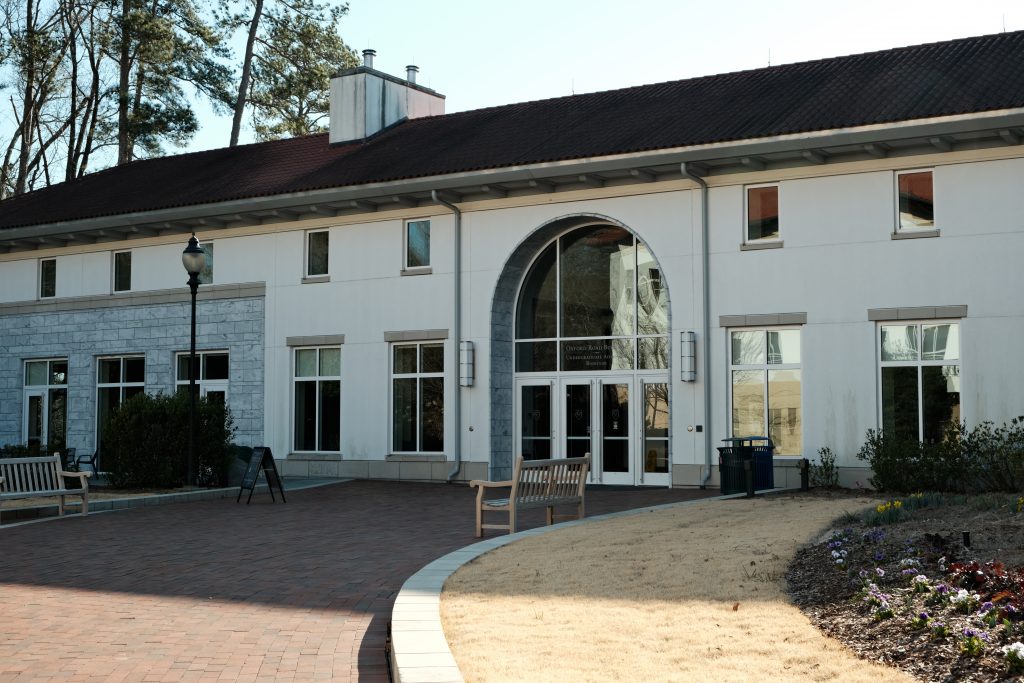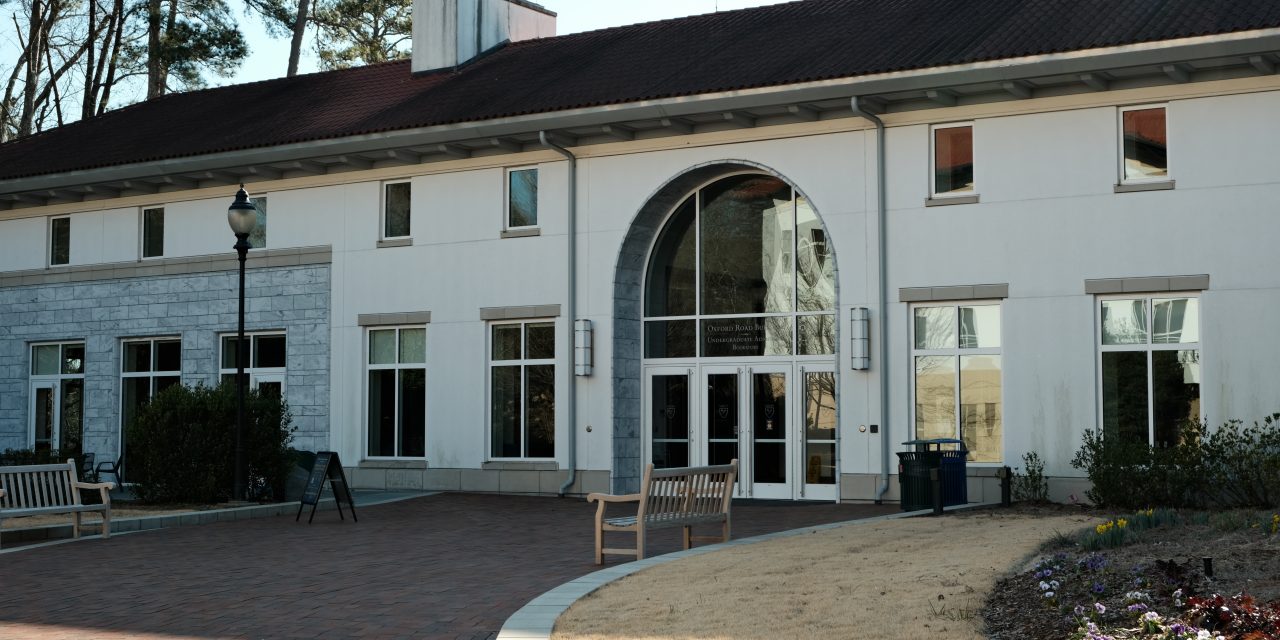The Supreme Court of the United States struck down affirmative action this morning in a joint opinion on two cases, effectively restricting colleges’ use of race as a factor in admissions. The rulings have implications for admission processes at public and private universities across the country.
In a 6-3 decision, the court ruled against the University of North Carolina (UNC) and Harvard University (Mass.) in Students for Fair Admissions (SFAA) v. UNC and SFAA v. President and Fellows of Harvard College, respectively.
University President Gregory L. Fenves wrote in an email to the Emory community that the University’s leadership team has been “actively engaged” in conversations about the implications of this decision at Emory.
“Emory’s current admissions process evaluates each applicant as an individual — looking at their talents and accomplishments as well as the distinct characteristics and experiences that have prepared them to contribute to our educational community,” Fenves wrote. “We will thoroughly review this process to determine what adjustments need to be implemented.”
The Supreme Court decisions considered whether race-conscious admissions processes violate the 14th Amendment and if Section VI of the Civil Rights Act of 1964 restricts race-conscious admissions at schools that receive federal funds. The cases disputed admission offices’ use of affirmative action at private and public institutions.
Conservative Justice John Roberts delivered the 40-page opinion of the conservative majority.
“The student must be treated based on his or her experiences as an individual — not on the basis of race,” Roberts wrote. “Many universities have for too long done just the opposite. And in doing so, they have concluded, wrongly, that the touchstone of an individual’s identity is not challenges bested, skills built or lessons learned but the color of their skin. Our constitutional history does not tolerate that choice.”
The decision to strike down affirmative action is rooted in the belief that Harvard and UNC did not meet the strict scrutiny standard, according to Associate Professor of Political Science Andra Gillespie. She explained that, due to the United States’ history of discrimination, all forms of discrimination — especially pertaining to race — is “suspect.”
“Even if the racial discrimination is intended to help people who have historically been marginalized, it has to be narrowly tailored to meet a compelling state interest, according to the doctrine of strict scrutiny, and the conservatives who are on the Court who now make up the majority believe that the University of North Carolina and the Harvard systems were not narrowly tailored to meet a compelling state interest,” Gillespie said.
Associate Professor of Political Science Bernard Fraga said the Court deemed institutions’ goal to increase diversity via affirmative action was “too difficult to measure,” overturning precedent.
“Schools were told that’s the reason you should use and now they said those reasons are not legitimate,” Fraga said. “That’s really surprising.”
Liberal Justice Sonia Sotomayor dissented, writing that the decision to strike down affirmative action “further entrench[es] racial inequality in education.” Liberal justices Elena Kagan and Ketanji Brown Jackson joined her dissent.
“Today, this Court stands in the way and rolls back decades of precedent and momentous progress,” Sotomayor wrote in dissent. “It holds that race can no longer be used in a limited way in college admissions to achieve such critical benefits. In so holding, the Court cements a superficial rule of colorblindness as a constitutional principle in an endemically segregated society where race has always mattered and continues to matter.”
Roberts also ruled that UNC’s and Harvard’s racial categories such as Asian and Hispanic are “plainly overbroad … arbitrary or undefined … or underinclusive.” However, Fraga explained that UNC and Harvard were required to use the racial categories by the federal government.
“Those are kind of the surprising parts of the ruling that basically put universities in a position where they said, ‘If you were doing the things that we literally told you to do for decades, you’re doing something wrong and unconstitutional,” Fraga said.
While the decision in both cases were largely expected because of the Supreme Court’s conservative majority, Jackson’s recusal from the SFAA v. Harvard case made this ruling even more likely. Jackson was a member of the Harvard Board of Overseers until 2022. In addition to Jackson, three other voting justices attended Harvard University.
SCOTUSPoll, an annual national survey of the public opinion surrounding Supreme Court cases led by Harvard, Stanford University (Calif.) and The University of Texas at Austin scholars, found that the majority of Americans are against affirmative action at both public and private institutions. However, distaste for affirmative action is typically associated with conservative beliefs.
U.S. President Joe Biden spoke out against the decision on June 29, stating that he believes “colleges are stronger when they are racially diverse.”
“I want to emphasize we cannot let this decision be the last word,” Biden said. “While the court can render a decision, it cannot change what America stands for.”
There are still several avenues colleges and universities can take to promote diversity in their application process while following the Supreme Court’s ruling, Gillespie said. For example, applicants can discuss how race affected their lives in their written answers, which can be considered in holistic review processes as long as the institutions focus on how the answers exhibit the applicants’ courage and determination rather than race itself.
Gillespie said she believes more institutions will begin using this tactic to ask about race in admissions.
“The decision completely allows for students to talk about diversity themselves,” Gillespie said. “An admissions officer can’t unknow what they just read in a student’s essay.”
Additionally, colleges and universities can promote racial diversity by remaining test optional and promoting socioeconomic diversity, according to Gillespie.
“That’s part of the reason why the justification for affirmative action in colleges is that given the fact that race tends to exacerbate socioeconomic disparities, and Black and brown people are going to be more likely to be socioeconomically disadvantaged, then if we look at class, that may actually be a proxy for race,” Gillespie said.
The decision has also raised questions about whether other factors, such as legacy status, should be removed from the college admissions process. Gillespie said some institutions may be more hesitant to remove legacy admissions out of fear of alumni halting their donations in retaliation.
Yasmeen Ahmed (24C) supports the idea of striking down legacy admissions.
“You can accept someone because their parent went there, their parent donated a library, but … you’re not going to take race into consideration?” Ahmed said. “It’s ridiculous because if they were to actually care about wanting to be fair, they would do away with all of that. Obviously that’s not what their priority is.”

Emory University’s Admissions Building sits on the edge of campus. (Lin Yu/Staff Photographer)
Case details
Edward Blum, SFAA founder and a conservative legal strategist, filed both cases. SFAA, a nonprofit, takes the stance that “race and ethnicity should not be factors that either harm or help … student[s] to gain admission to a competitive university.”
In the Harvard case, SFAA alleged that the institution’s admissions process discriminates against Asian American applicants in favor of white applicants. They asserted that this violates Title VI of the Civil Rights Act of 1964, which establishes that nobody in the United States can be excluded from or face discrimination under “any program or activity receiving Federal financial assistance” on the basis of “race, color or national origin.”
Harvard has admitted to using race as a factor in its admissions process, with the Harvard Gazette reporting that “race only ever functions as a plus factor and is never used to deny qualified applicants’ admission.”
However, Harvard argued that its use of race as one of many admissions factors adheres to the requirements for race-based admissions outlined in the Supreme Court’s 2003 decision in Grutter v. Bollinger, in which a white Michigan resident challenged the University of Michigan Law School’s race-conscious admissions program after being denied admission. The Supreme Court found that the use of race as one factor in admissions is just as long as institutions holistically review applicants and the process is used to promote diversity among students.
In SFAA v. UNC, SFAA sued UNC over its admissions process, alleging that the institution’s use of race as an admissions factor violated the 14th Amendment, which granted citizenship to anyone “born or naturalized in the United States,” including formerly enslaved peoples, and established that all citizens have “equal protection under the laws.” The ratification of the 14th Amendment paved the way to the Civil Rights Act of 1964, which SFAA is accusing Harvard of violating in the case.
Similarly to Harvard, UNC has admitted to considering race in its admissions process, reporting that they “consider race or ethnicity flexibly, as one factor among many, in assessing all [they] know about an applicant,” although applicants are not required to report their race or ethnicity. UNC also argued that their admissions process adheres to the requirements in Grutter v. Bollinger.
However, the majority opinion ruled that the institutions’ admissions programs must be “invalidated” under the 14th Amendment, which Fraga said ignores the “practical reality” of how the 14th Amendment has and has not been implemented to protect historically disadvantaged groups.
“There seems to be a profound ignorance of both history and reality in the way the majority invokes the 14th Amendment,” Fraga said. “What I’m looking for is, perhaps, universities to now do a better job of looking at the reality on the ground and thinking about advancing equality, advancing justice and remedying historical injustice in the policies that they push moving forward. Perhaps doing a better job of recognizing history than the Court demonstrated they were willing to do in this decision.”
SFAA v. Harvard and SFAA v. UNC were originally consolidated for oral argument, but the Supreme Court ultimately severed the two cases.
History of affirmative action
The term “affirmative action” was first used by former President John F. Kennedy in Executive Order 10925, which he signed on March 6, 1961.
The executive order states that affirmative action should ensure that applicants are employed and employees are not treated on the basis of “race, creed, color or national origin” when it comes to factors such as employment, promotions, demotions, transfers, recruitment, termination, payment and training.
The Supreme Court has modified the practice of affirmative action in college admissions throughout the years.
In Regents of the University of California v. Bakke in 1978, the Supreme Court considered whether favoring the admission of minority applicants could create less opportunities for white applicants without violating the Constitution. The University of California, Davis School of Medicine used a racial quota system for admissions, reserving 16 out of 100 seats for minority students. While the Supreme Court ruled that schools were not allowed to use racial quotas for admissions, they upheld affirmative action by allowing race to be a factor colleges could consider in admissions.
The University of Texas’ use of affirmative action became the subject of debate in the Supreme Court in the 2013 case Fisher v. University of Texas. The institution complied with a 1997 law requiring all state-funded universities to guarantee admission to Texas students graduating in the top 10% of their high school class, but considered race as an admissions factor for the remainder of in-state applicants.
Abigail Fisher, a white student who did not graduate in the top 10%, filed suit against the University of Texas at Austin after being denied admission, alleging that the admissions process violated the 14th Amendment. Fisher ultimately took the decision to the Supreme Court where the court ruled in the University’s favor.
University President Gregory Fenves was early in his term as the University of Texas president when the Supreme Court released its 2016 decision. Fenves reflected on this “historic” decision in an October 2022 op-ed for the Hill, writing that the Supreme Court validated the “educational benefits of diversity” and upheld precedents set by the Regents of the University of California v. Bakke and Grutter v. Bollinger.
“At the time, I remember feeling pride and also relief,” Fenves wrote.
Impact on Emory
From the Class of 2025 to the Class of 2027, members of “historically underrepresented groups” admitted into Emory increased by 5.4 percentage points, according to Emory News Center reports. Emory defines students who fall into this group as those who are Black/African American, Hispanic/Latino, American Indian/Alaska Native or Native Hawaiian/other Pacific Islander.
In the Class of 2025 admission cycle, 28% of admitted students fell into this category. That percentage increased to 33% for the Class of 2026 and 33.4% for the Class of 2027.
Similar trends follow for matriculated students. In fall 2022, 32.7% of Emory undergraduates were white. This is followed by students who identify as Asian (24.3%), international (17.6%), Hispanic/Latino (11.1%), Black/African American (8.5%) and two or more races (4.4%). Less than five undergraduates were American Indian/Alaskan Native or Native Hawaiian/other Pacific Islander.
Between fall 2018 and fall 2022, the number of Asian undergraduates increased by 13.37%, Black or African American students increased by 9.35%, Hispanic/Latino students increased by 12.19%, international students increased by 4.89% and students of two or more races increased by 11.22%. The amount of enrolled white undergraduates decreased by 13.87%.
These trends mirror the demographic pattern of first-years entering Emory College. Between fall 2018 and fall 2022, the number of Asian students entering Emory College increased by 7.42%, Black or African American students increased by 32.04%, Hispanic/Latino students increased by 11.47% and international students increased by 4.85%. White students decreased by 19.22%.
Emory University has expressed support for considering race in higher education admissions amid the lawsuits. In 2022, Emory joined 14 other universities in filing an amicus brief with the Supreme Court for the Harvard and UNC cases.
“Diversity fosters a more robust spirit of free inquiry and encourages dialogue that sparks new insights,” the universities wrote. “Diversity encourages students to question their own assumptions, to test received truths and to appreciate the complexity of the modern world.”
Emory also expressed support for Harvard in 2018, when the University and 15 other institutions filed an amicus brief with the United States District Court for the District of Massachusetts. Nearly two years later, Emory and 14 other institutions filed another amicus brief siding with Harvard with the U.S. District Court of Appeals for the First Circuit.
Fenves, who was a professor at the University of California, Berkeley (UC Berkeley) in 1996 when Proposition 209 went into effect to ban affirmative action in California public universities, wrote that UC Berkeley’s minority student population was cut in half and continues to battle the lasting effects.
In his email to the Emory community, he wrote that “diversity remains a bedrock value” for Emory.
“It is reflected in our students, whose talents define the Emory experience,” Fenves wrote. “Our commitment to diversity is a commitment to them. As we move forward together, I will continue to champion this cause while fighting to improve access to an Emory education.”
Ahmed noted that the Emory community should have open conversations and be aware of how this decision can impact students of color.
“That’s the whole point of diversity in college is to recognize other people’s points of view and the way they grew up and how they have gotten here and all the struggles they’ve gone through to get to this point,” Ahmed said. “It’s just going backwards. It’s so disheartening and discouraging to see this.”
Update (7/12/2023 at 4:03 p.m.): This article was updated to include comments from Associate Professor of Political Science Andra Gillespie, Associate Professor of Political Science Bernard Fraga and Yasmeen Ahmed (24C).








